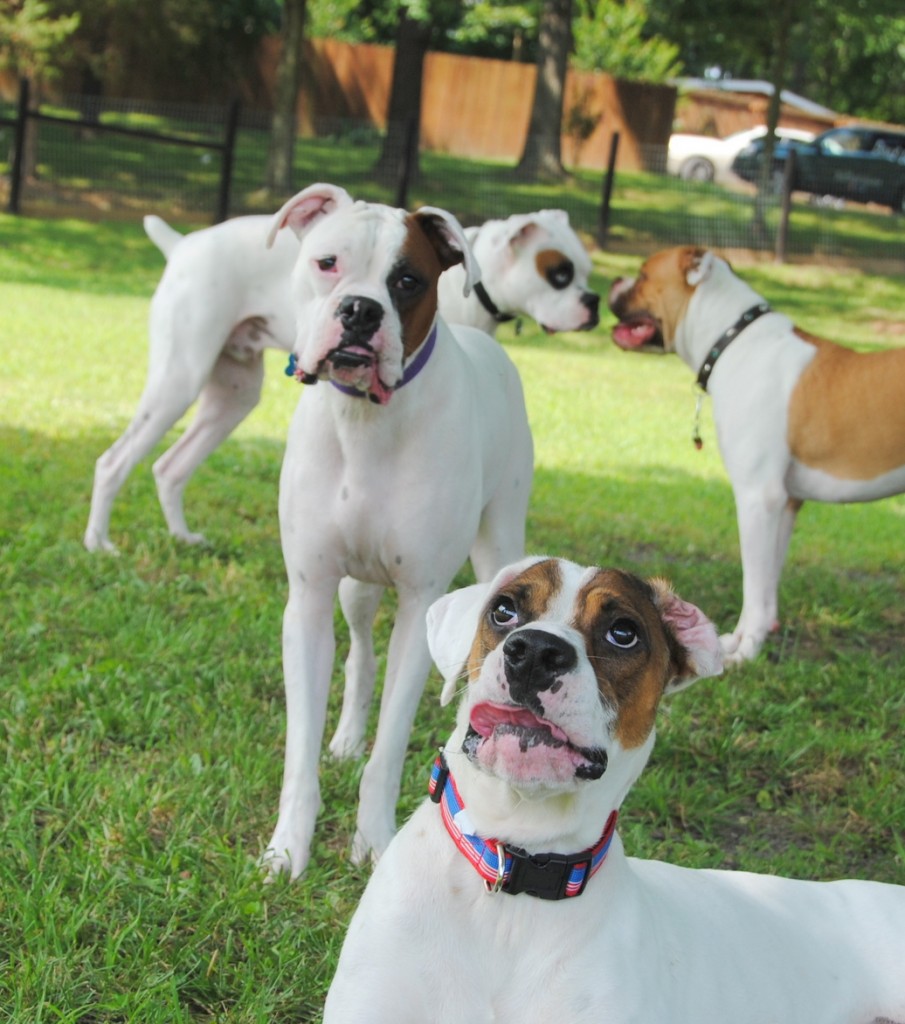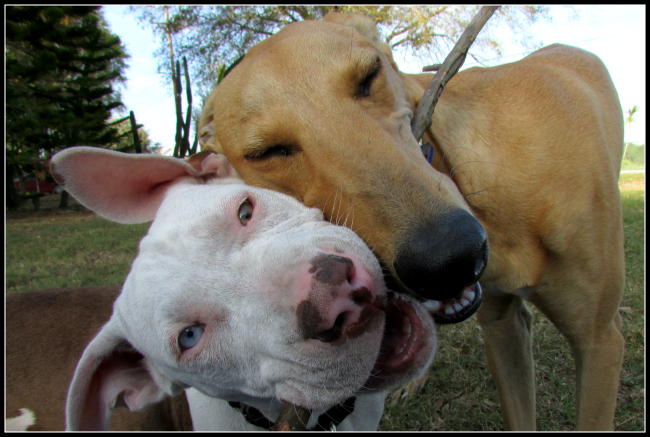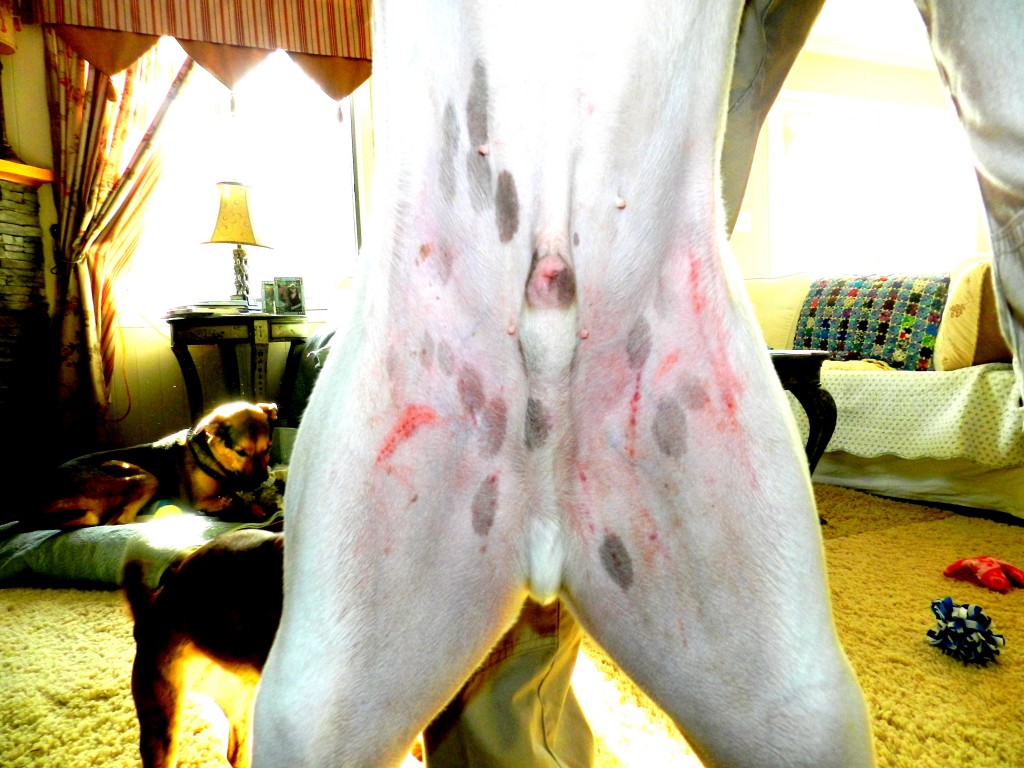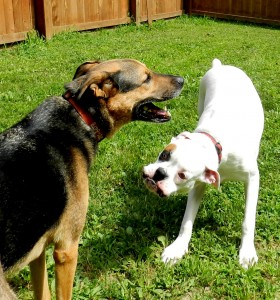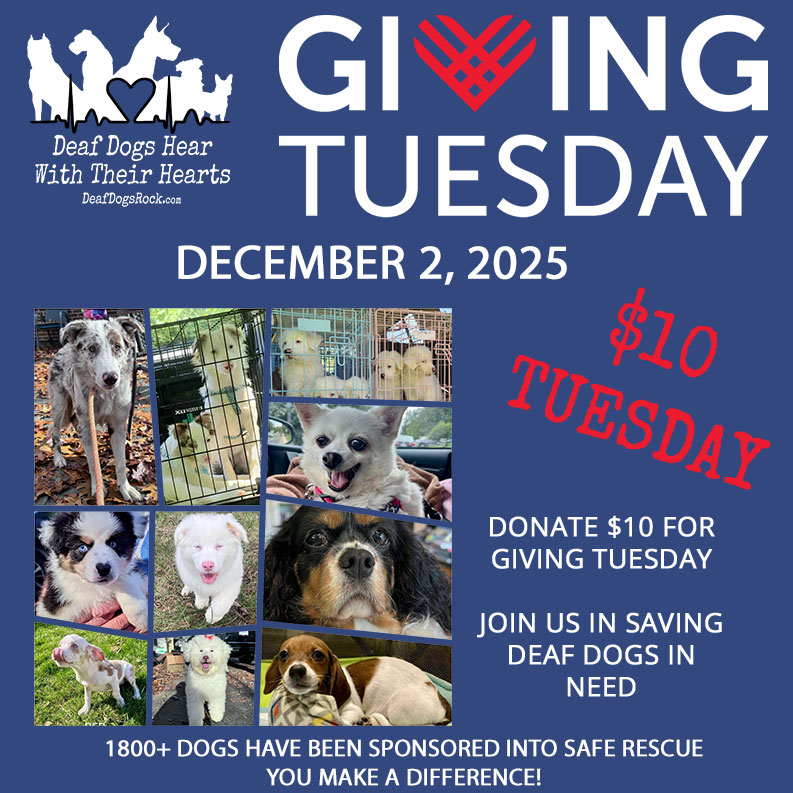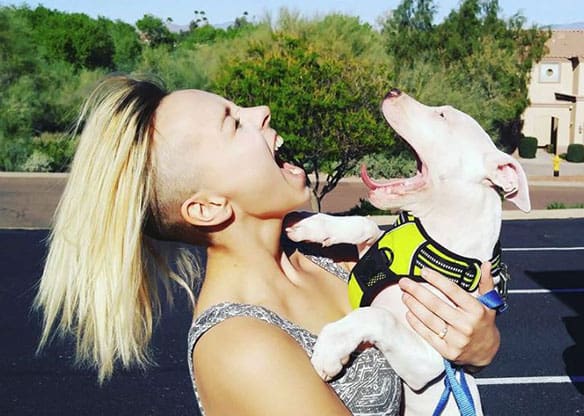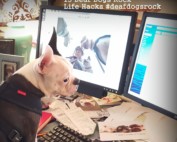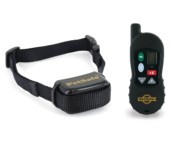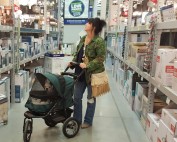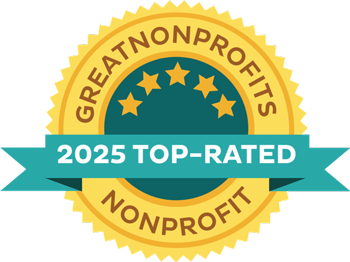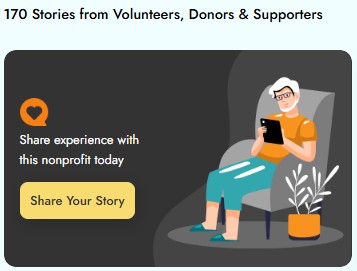Update November 2015: This is a post I did three years ago when Chris, Nitro and I were fairly new to dog parks. We have since become very dog park savvy since this happened. We don’t go to the dog park very often anymore. If we do go to a dog park, now we will sit in the car for a while when we get to the dog park just to make sure there are good dogs in the park having fun. If a big un-neutered dog comes in the park we leave and don’t look back.
I know many of our followers will tell us they hate dog parks but my two deaf dogs Bud and Nitro love the dog park. Especially Bud. He loves all dogs and he loves to play with them. We don’t go to the dog park as much as we used to because we built a dog park here on the farm and invite our dog loving friends to join us for play dates. I try to take Nitro and Bud to the dog park about once a week during the slow part of the day to keep them socialized.
Also not long ago I noticed that Nitro gets very upset if there is a big group of dogs running and they slam into him by accident because he is deaf. He is usually facing the opposite direction and the dogs in the pack are not watching where they are going and before I know what’s going on they slam into him. Poor Nitro can’t hear them coming! He always looks shaken and upset so right there I am failing at being his advocate by not placing him out of harms way. Now I do play very close attention and because he has been hit a few times he sticks to me like glue. Bud on the other hand could care less if he gets run into because he will shake it off and then join the dogs who are running. They both have such different personalities when it comes to play groups. From this day forward it will be my job to make sure this never happens again. If I see a big group of dogs playing and running, I tap Nitro on the shoulder, ask him to come with me and we go over near the trees and fence and out of the wide open spaces so he cannot be hit by mistake.
Just remember, always have your deaf dog’s best interests in mind and always have his back. It is very important as a deaf dog owner to always be your deaf dog’s advocate in any situation.
As many of you know we used to take our sweet well mannered deaf dog Nitro to our local dog park. We used to go to our local dog park every day and Nitro loved to play with all of his doggy friends. The last couple of times we have gone to the park we have noticed a few unaltered male dogs humping. Sometimes it’s not a problem because if they are usually corrected by responsible dog owners. Most dog owners will go right up to their dogs and redirect them. This is a good time for the dog owner to redirect and make it a positive dog training moment at the dog park.
A few years ago when Nitro was still pretty young, Chris and I took Nitro to the dog park there was a unaltered Bull Terrier aggressively started humping Nitro.
I was standing next to the owner and I said “who’s dog is this aggressively humping my dog? This bully dog is going to tear up my dogs underbelly?” The man next to me said “oh that’s my dog and that’s just how he plays.” I told him he wasn’t playing at all. I know my dog certainly wasn’t having fun so I asked him to get control of his out of control dog. Well he told me he didn’t understand why some humans don’t have a clue or understand how dogs play. Really, that’s the best he could come up with at the time? This man’s dog was behaving very badly and he called it “playing”. Okay, so you guys know me pretty well. Do I seem like a clueless dog owner to all of you?
Photo above: This is a photo of Nitro’s underbelly after the humping incident at the Dog Park. As you can see, this is the damage after just a couple of minutes of an out of control “humper” dog gripping Nitro with his two front paws. He was pretty torn up. If my proactive husband Chris wouldn’t have been there to thrown the dog off Nitro at least six times, it would have been much worse. Since this incident happens, now we sit in the car with our dogs and watch how the dogs in the dog park are behaving. If we see a dog that looks like it is a problem, then we don’t go in the dog park. We go walk our dogs on the Greenway trails instead of going to the dog park.
Don’t ever be afraid to speak up and be your dog’s advocate in any situation.
The rude man at the dog park was not his dog’s advocate or he would have put a little effort into redirecting his dog’s bad behavior. If this dog aggressively humps an dominate dog running in a pack you can be sure there will be a fight breaking out sooner or later. If the man with the Bull Terrier had not removed his un-neutered bull terrier from the park when I spoke up, we would have had no other choice then to leave with Nitro. As it turned out when we got home Nitro’s underbelly was completely torn up (see above photo).
As a general rule of thumb you should not touch another person’s dog unless you are doing it for the safety of your own dog like my husband Chris did to protect Nitro. Nitro always looks to me for direction and he knows I always have his back no matter what is going on. When he feels threatened he always heads in my direction. With that being said, I wanted to share some dog park etiquette rules (these seem to be the general rule of thumb in most of the internet searches I did).
Almost every dog etiquette search I found mentioned dog owners should not bring unaltered males to a dog park unless they are very well mannered. I don’t have a problem with the unaltered male dog part, I have a problem with the unaltered male dog with poor manners (and the owner of said dog just standing by idly and doing nothing while my dog is being mauled by his dog). At our dog park we have some very well behaved in tack males but their owners have taken a lot of time to teach them good canine manners.
This is from www.dogparkfriends.org – Park Etiquette
Aggressive dogs are not allowed. The handler of any dog exhibiting aggressive or unruly behavior is required to immediately remove the offending animal. The owner/guardian of an unruly dog is fully responsible for the actions of the dog.
APPROACHING THE DOG PARK
* Keep dogs on leash until they are inside the double gate. The animal shelter shares the same parking lot as the dog park and they may have dogs and/or cats in the parking lot being introduced to people.
* Make sure the first gate is closed before entering the second gate. If the outer gate is open, there is always a chance that a dog can run out of the park.
* Unleash your dog in the double gate area before entering the park. A dog often feels vulnerable being on leash while other dogs around it are off leash. The leashed dog knows that it cannot maneuver freely and cannot get away if it wants to. This sense of vulnerability may lead to aggression.
* Users already inside the park should call their dogs away from the gate until the new arrivals have entered. It’s difficult for a new arrival to enter the park if a wall of dogs is blocking the gate. Dogs are territorial creatures, and the boundaries of a territory are flash points for aggression. Once the dog is inside the territory, the chances for conflict are much less. If people are not calling their dogs to them when you are about to enter, you may ask them to call their dog, or stand there until their dog walks away.
* Remove metal collars. This includes prong or “pinch” collars, choke chains, and spike collars. There is the risk of other dogs breaking their teeth on the collar, especially if engaging in mouthy play.
* Know your dog’s play style. Some dogs like a very rough-and-tumble style of play, with lots of growling, grabbing, tackling, and wrestling. Some dogs have a daintier style, with bowing and chasing but not much physical contact. Some dogs like to herd other dogs, and may bark or nip at the other dogs. The important thing is to know what is normal for your dog, and what the warning signs are that your dog may be getting over-stimulated and may be in danger of crossing the line into aggression. It’s also important to be sensitive to the other dogs with whom your dog is playing. You should always watch your dog closely and be prepared to intervene if the interaction seems to be getting out of hand or becoming too uncomfortable for a particular dog. If your dog seems to be “pestering” another dog who seems to be growing stressed or annoyed, intervene and direct your dog’s attention elsewhere.
* Understand canine communication. Dogs that enjoy rough play may growl and snap as part of that play. Dogs may also snarl and/or snap to “set their limits” with other dogs-for example, to let another dog know that it is being too rough or too pushy.
* Dogs are programmed to be part of a pack, with some dogs being higher in the pack hierarchy (dominant) and others being lower in the hierarchy (submissive). Dogs have various ways by which they communicate their dominance to other dogs. This may include a stiff-legged posture with the head held up and back; raising the hackles on the back; raising the tail; or laying the head across another dog’s shoulders or back. If you see two dogs exchanging dominant gestures with each other, watch carefully and be ready in case a fight is brewing.
* Mounting (“humping”) is often a way by which one dog expresses dominance over another. Do not allow your dog to mount another dog, as this behavior is very likely to lead to a fight. Even if your dog means no harm, the other dog is very likely to take offense. Sometimes this can be done in play, watch carefully to see how each dog is feeling.
* Respond promptly to aggressive behavior. Deciding what constitutes aggressive behavior is sometimes a matter of judgment. It’s important to know your dog and to know what is normal and safe for your dog.
* Dogs displaying significant aggression toward other dogs, or any aggression toward humans, must be leashed and removed from the park for the day. This is not only for the safety of other park users-it can also help with the dog’s own education. A dog soon realizes that aggressive behavior earns it a one-way ticket out of the park-and many dogs quickly learn to mind their manners.
* You may find that your dog gets along better with certain dogs, or with certain types of dogs, than with others, and you may want to avoid entering the park when there are dogs with whom your dog has a problem.
* A dog that repeatedly displays aggressive behavior with a variety of dogs is not a good dog park candidate and should stop coming to the park.
* It is recommended that dogs be spayed or neutered before coming to the dog park. Be aware that unneutered males in particular are much more likely to get into fights with other male dogs. ** Females in heat may not enter the park.
* Dress for the mess- Do not overdress. No, it’s not polite for dogs to jump on people, but it may happen. At the dog park you should expect dirt, mud, slobber, wet dogs, and yucky toys in your lap. Please know that grime is part of the scene
DEAF DOG PARK ETIQUETTE by Christina Lee – Deaf Dogs Rock
Be sure to check your dog’s collar to make sure it is not loose and fits properly. Another dog can easily get trapped under your deaf dog’s collar by locking it’s jaw under your dog’s loose collar. Make sure you can only get to fingers under your dog’s collar before you enter the park.
Always clean up after your dog and be sure to bring your own poo bags because many times the park is out of bags
If your dog is crowding the gate when others are trying to enter the dog park, be sure to rush over and pull your dog away from the gate.
Always unleash your dog immediately (the best time is do do it in the entry point before you open the gate) because a deaf dog can feel trapped on a leash if a group of dogs rush up to him. Remember a deaf dog can also feel your anxiety if you are nervous about letting your dog off the leash for the first time.
If it is your first time drive by the dog park and figure out when the slow times are and then stop by when there is only a few dogs around.
Be sure to park and sit in your car for a few minutes so you can watch the dogs in the dog park before your take your dog in the play area. This way you can feel safe knowing that the dog’s in the dog park seem to all be well behaved. Also be sure to watch the owners of each dog. If you see a person sitting on the bench watching YouTube and not watching their dog, be aware of how their dog behaves when they are not paying attention.
It is very important to enter and keep walking (and feel free to ask others to join you by walking away from the gate). When you keep walking forward, your dog will also keep moving (and then the pack will be fluid as well so your dog doesn’t feel trapped by being surrounded by 5-10 dogs rushing up to him all at once).
Try to keep your cell phone in your pocket so you can pay close attention to your dog and the dogs your dog is interacting with to make sure he is safe.
I always watch the other dogs in the dog park to see if they have negative body language when they are near my dog (stiff tail, hackles up, stiff body language, head held high, no side to side meeting ect.)
Each dog is different. My dogs can be very loud and growl loud at home but are very quite at the dog park. Watch for other dog’s growling, snarling or snapping at your dog.
Watch to make sure your dog does not get overstimulated or the dogs in the play group don’t get overstimulated.
When dogs get overstimulated (or tired), they act out because they want to take a break. Don’t let your dog get so tired to the point he has to lunge at the other dogs in the pack. If this happens it is time for your dog to take a break.
Always redirect any aggressive behavior you see. Redirection could mean just getting your dog and giving him a break or by giving your dog a sign that it is “time to drive home”.
Do not bring food to eat and politely ask others to respect the NO food rule that is posted at all dog parks.
Follow all the posted rules. I know this is hard because most people do not follow the rules. We have a sign that says NO TOYS and yet sometimes I drive by and see people throwing dogs or walk in and see toys all over the grounds of the dog park.
Do not hand out dog treats to other peoples dogs or to your dogs. If you are doing some training at the dog park (make sure it is at a slow time of the day) and you want to reward your deaf dog for a long distance recall be sure to give your dog a treat on the down low.
Practice “Recall Training” with your deaf and hearing dogs. My deaf dogs have gone through serious “watch me” and “recall” training so when we are at the dog park both of my deaf dogs Nitro and Bud check with me often. Many times I will do a recall, give them a thumbs up, a belly rub (sneak them a reward treat if no other dogs are around) and send them back out to play.
Do not just call your dog when you are ready to leave or your dog will figure out when ever you call him it is time to leave. I once helped an owner who had been trying to catch his dog at the dog park. He had been trying for four hours before Nitro and I arrived. He was very lucky his dog loved Nitro so when we walked in and she rushed up to Nitro, I got a hold of her collar so they could finally go home. He learned a very valuable lesson that day.
Always be very polite when talking to other dog owners at the park. I have learned some people just don’t like you to call them out on their dog’s bad behavior. If a heated discussion starts it is always best (and safer) to just leave the dog park and come back at another time.
Always bring a towel to dry your dog off and wipe him before he gets back in the car (especially when there has been a lot of rain).
Nitro, Bud, Bowie and I hope you have a wonderful time at your local dog park and please remember to always be your dogs advocate.
Well behaved Deaf Dogs ROCK!
~ Christina and Nitro

